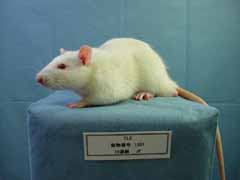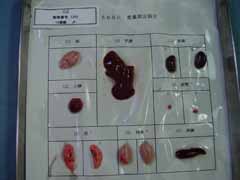| NBRP Rat No: 0271 |
Strain name: TLE/Utp |
Commmon Name: TLE, Tsukuba low-emotional rat |
Rat Genome Database |
| Principal Investigator: |
Katsunori Kato University of Tsukuba 1-1-1, Tennodai, Tsukuba 305-8577 Ibaraki Japan |
| Tel: 029-853-4881/6093 Fax: 029-853-4881/6093 |
Email: kkato@human.tsukuba.ac.jp |
| Preservation Status: |
Embryo Sperm Living Animals |
 |
 |
| Coat Color |
albino (c) |
| Inbred Generations |
F84+11 (May 2008) |
| Usage Restrictions |
In publishing, a citation of the following literature designated by the DEPOSITOR is requested.
Fujita, O., Annen, Y., and Kitaoka, A. (1994) Tsukuba high- and low-emotional strains of rats (Rattus norvegicus): an overview. Behavior Genetics, 24, 389-415. |
| Genetic Status |
|
| Comercial Availability |
|
|
| Research Category |
|
| Gene Affected |
|
| Origin |
In 1972, Fujita began selective breeding for differences in ambulatory activity in the runway test. Two strains have been separated from each other and established as inbred strains. The inactive strain was named the Tsukuba High-Emotional (THE, NBRP No.0270); the active one, the Tsukuba Low-Emotional (TLE, NBRP No.0271) (Fujita, 1984). (Jun 4, 200) |
| Strain characteristics |
The THE and TLE strains have been selected, respectively, for low and high activity in a runway test. During the course of selection, defecation has increased in the THE strain and decreased in the TLE strain. These strain differences were not affected by maternal influences, early experience, or psychotropic drugs. THE rats were consistently inactive in all novel situations examined, while TLEs were very active. The level of spontaneous activity, however, was similar between the two strains. It was remarkable that THE rats showed more burrowing activity than TLE animals, whereas the latter displayed more aggression than the former. Differences in learning ability, concentration of neural transmitters, and social behavior were examined (Fujita, 1994). (Jun 4, 200) |
| Breeding Conditions |
Originally individuals were selected for sib mating by the Runway Test, every generation until F35 and every 5th generation after F36 until F50. At present, they are maintained only by sib mating. The breeding is difficult because of filial cannibalism. |
| Genotyping |
|
| References |
阿部勲・藤田統・中村則雄 1977 高・低情動反応性系ラットの行動比較 -Home-cage Activity- 東京教育大学教育学部紀要, 23, 61-66.
安念保昌 1986 情動性に関して選択交配されたラットにおける侵入者攻撃と順位行動 ―情動性と社会的体制化― 心理学研究, 57, 273-280.
安念保昌 1988 攻撃行動の遺伝 遺伝, 42, 27-32.
安念保昌 1989 情動性に関して選択交配されたラットにおける社会行動の系列構造と発達的変化 心理学研究, 59, 326-333.
Annen, Y. & Fujita, O. 1984 Intermale aggression in rats selected for emotional reactivity and their reciprocal F1 and F2 hybrids. Aggressive Behavior, 10, 11-19.
Annen, Y. & Fujita, O. 1985 Relationship between emotionality of intruders and aggressive behavior of residents in rats. Japanese Psychological Research, 27, 119-124.
Annen, Y. & Fujita, O. 1985 Septal lesions and biting attacks in rats bidirectionally selected for emotionality. Behavioral and Neural Biology, 43, 132-142.
安念保昌・中津山英子・和田由美子・藤田統 1992 Tsukuba情動系20年間の家系図 筑波大学心理学研究, 14, 1-13.
Fujii, M., Asada, M., Takata, N., Yamano, A. & Imada, H. 1989 Measurement of emotional reactivity and association ability of the Tsukuba emotional strains of rats (Rattus norvegicus) in licking and lever-pressing conditioned suppression situations. Journal of Comparative Psychology, 103, 100-108.
藤田統 1988 Tsukuba 情動系ラットのランウェイ・テストにおける遺伝とシェルター付きオープン・フィールドにおける行動の分析 筑波大学心理学研究, 10, 53-67.
藤田統 1989 Tsukuba情動系ラットの味覚嫌悪学習 - 高・低情動反応性系ラットの行動比較(51) 筑波大学心理学研究, 11, 23-34.
Fujita, O., Annen, Y., & Kitaoka, A. 1994 Tsukuba high- and low-emotional strains of rats (Rattus norvegicu): an overview. Behavior Genetics, 24, 389-415.
藤田統・鎌塚正雄 1982 ラットにおける食物獲得競争テストの検討 -交.低情動反応性系ラットの行動比較(7) 筑波大学心理学研究, 4, 1-6.
藤田統・片山尊文 1981 高・低情動反応性系ラットの行動比較:5 -能動的回避学習 と受動的回避学習- 筑波大学心理学研究, 3, 1-6.
藤田統・加藤宏・安念保昌・増井誠一郎・北岡明佳・中津山英子 1990 Tsukuba情動系ラットの野外フィールドにおける4年間の個体 数の推移とそれに関連する雄の性行動 筑波大学心理学研究, 12, 37-45
藤田統・中村則雄・宮本邦雄・片山尊文・鎌塚正雄・加藤宏 1980 選択交配により作られた高・低情動反応性系ラットの行動比較 筑波大学心理学研究, 2, 19-31.
Imada, H. 1972 Emotional reactivity and conditionability in four strains of rats. Journal of Comparative and Physiological Psychology, 79, 474-480.
Iso, H., Brush, F.R., Fujii, M., & Imada, H. 1988 Running-wheel avoidance learning in rats (Rattus norvegicus): effects of contingencies and comparisons of different strains. Journal of Comparative Psychology, 102, 350-371.
加藤宏 1987 ランウェイ・テストを指標としたラットの情動反応性の選択交配:3 -生物学的適応- 筑波大学心理学研究, 9, 57-65.
加藤克紀・牧野順四郎 2001 活動性を規定する情動因子 体育の科学, 51, 688-693.
北岡明佳・藤田統 1991 ランウェイ・テストの構造とTsukuba情動系ラットの行動 筑波大学心理学研究, 13, 67-71.
Kitaoka, A. 1991 Emergence from home cage in rats(Rattus norvegicus) as a function of strain and sex. Japanese Journal of Animal Psychology, 41, 28-33.
Kitaoka, A. & Fujita, 0. 1991 Behavioral comparisons of the Tsukuba Emotional strains of rats (Rattus norvegicus) in three types of novel situations. Behavior Genetics, 21, 317-325.
Kitaoka, A. 1994 Defensive aspects of burrowing behavior in rats (Rattus norvegicus) : A descriptive and correlational study. Behavioural Processes, 31, 13-28.
Nageishi,Y. & Imada, H. 1974 Suppression of licking behavior in rats as a function of predictability of shock and probability of conditioned-stimulus-shock pairings. Journal of Comparative and Physiological Psychology, 87, 1165-1173.
Naito, H., Inoue, M., & Makino, J. 2000 Ultrasonic isolation calls in genetically high- and low-emotional rat pups. Experimental Animals, 49, 289-294.
Naito, H., Inoue, M., Suzuki, Y., Tohei, A., Watanabe, G., Taya, K. & Makino, J. 2001 Ultrasonic vocalization responses in genetically high- and low-emotional rats. Experimental Animals, 50, 285-291.
中村則雄 1981 ランウェイ・テストを指標としたラットの情動反応性の選択交配:2 -選択基準とその他の測度との関係- 筑波大学心理学研究, 3, 33-38.
中村則雄・阿部勲・藤田統 1978 高・低情動反応性系ラットの行動比較:2 -
オープンフィールド行動と貯蔵行動 心理学研究, 49, 61-69.
中村則雄・藤田統 1979 高・低情動反応性系ラットの行動比較:3 -VocalizationとDefecation- 筑波大学心理学研究, 1, 11-16.
中村則雄・藤田統 1980 高・低情動反応性系ラットの行動比較:4 -初期経験の効果(その1)高架式直線走路と水中直線遊泳路- 筑波大学心理学研究, 2, 13-18.
中村則雄・藤田統・加藤宏・鎌塚正雄 1982 高・低情動反応性系ラットの行動比較:6 -F1を加えた分析(その1)飲水行動- 筑波大学心理学研究, 4, 33-39.
中津山英子・牧野順四郎 1998 第65世代Tsukuba情動系ラットのランウェイテストにおける移動活動 筑波大学心理学研究, 20, 23-29.
小貫泰広・加藤克紀・牧野順四郎・中津山英子 2003 Tsukuba情動系ラットにおける餌運搬行動 動物心理学研究, 53, 71-77.
Wada,Y. & Makino, J. 1997 Defensive burying in two strains of rats selected for emotional reactivity. Behavioural Processes, 41, 281-289.
和田由美子・牧野順四郎 1999 情動反応性によって選択交配されたラットの行動薬理 脳の科学, 21, 1103-1107.
和田由美子・中津山英子・細川裕士 1999 Tsukuba 高・低情動系ラットの妊娠率と仔食い率 筑波大学心理学研究, 21, 67-71.
|
| Additional strain information |
THE TLE |
|
|